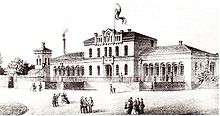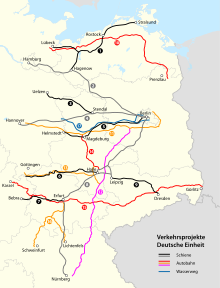Hagenow Land – Schwerin railway line
| Hagenow Land – Schwerin | |||||||||||||||||||||||||||||||||||||||||||||||||||||||||||||||||||||||||
|---|---|---|---|---|---|---|---|---|---|---|---|---|---|---|---|---|---|---|---|---|---|---|---|---|---|---|---|---|---|---|---|---|---|---|---|---|---|---|---|---|---|---|---|---|---|---|---|---|---|---|---|---|---|---|---|---|---|---|---|---|---|---|---|---|---|---|---|---|---|---|---|---|---|
| Route number : |
Hagenow-Holthusen: 6442 Holthusen-Schwerin: 6441 |
||||||||||||||||||||||||||||||||||||||||||||||||||||||||||||||||||||||||
| Course book section (DB) : | 100 | ||||||||||||||||||||||||||||||||||||||||||||||||||||||||||||||||||||||||
| Route length: | 6442: 18.647 km 6441: 9.699 km |
||||||||||||||||||||||||||||||||||||||||||||||||||||||||||||||||||||||||
| Gauge : | 1435 mm ( standard gauge ) | ||||||||||||||||||||||||||||||||||||||||||||||||||||||||||||||||||||||||
| Power system : | 15 kV 16.7 Hz ~ | ||||||||||||||||||||||||||||||||||||||||||||||||||||||||||||||||||||||||
| Top speed: | Hagenow – Schwerin center: 160 km / h | ||||||||||||||||||||||||||||||||||||||||||||||||||||||||||||||||||||||||
|
|||||||||||||||||||||||||||||||||||||||||||||||||||||||||||||||||||||||||
The Hagenow – Schwerin railway is a double-track, electrified main line in Mecklenburg-Western Pomerania . It is the second oldest railway line in Mecklenburg after the Berlin – Hamburg line.
Route
From the Hagenow Land train station east of the small town of Hagenow , the route runs almost in a straight line in a north-east direction through wooded areas to Schwerin . From Holthusen , where the line from Ludwigslust joins, it goes almost directly north towards Schwerin. The route from Parchim joins before Schwerin-Görries . Schwerin is cut through by a ditch from the railway line.
history
On February 25, 1846, the previously founded Schwerin-Wismarsche Railway Company, the Hagenow-Schwerin-Rostocker Railway Company and the Güstrow-Bützow Railway Company became the Mecklenburg Railway Company . With a view to the Berlin-Hamburg Railway , which was already under construction , the first railway line on Mecklenburg soil, the Mecklenburg Railway Company applied for a concession to build a railway line from Hagenow to Schwerin , which it received on March 10, 1846. Immediately afterwards, the construction of the route began. The Hagenow – Schwerin section was opened on May 1, 1847, and in the following years connections were established from Wismar , Rostock and Güstrow , which were connected to Berlin and Hamburg in Hagenow Land.
Initially, two pairs of trains ran between Rostock and Hagenow each day with feeders to Wismar and Güstrow. With the construction of further railway lines in northern Germany, however, the importance of the Hagenow – Schwerin line decreased. By Lübeck-Bad Kleinen railway traffic towards Hamburg was passed over Lübeck from the 1870th Since the connection from Ludwigslust to Holthusen went into operation in 1888 , traffic in the direction of Berlin and Magdeburg has also shifted to this somewhat shorter route. From then on, the Hagenow - Schwerin railway line primarily served local traffic. In 1905, for example, five pairs of passenger trains commuted between Schwerin and Hagenow Land, and six in 1934, some of them further to Wismar. In the 1980s there were four pairs of trains that continued to the Schwanheide border station . There was also a pair of express trains , an interzone train to Hamburg.
On December 31, 1992, a serious rear-end collision occurred in the Holthusen train station when the express train from Rostock to Leipzig collided head-on with a shunting locomotive.
After German reunification , the line was expanded as part of the German Unity No. 1 traffic project (Lübeck / Hagenow Land – Rostock – Stralsund). The 18 km long section from Hagenow Land to Holthusen was extended by a second track and electrified. The Holthusen station was rebuilt so that trains from Hagenow Land to Schwerin can travel at 160 km / h and from Ludwigslust at 130 km / h. The platforms in Schwerin main station were lengthened and the station equipped with an electronic signal box, from which the section from Hagenow Land to Bad Kleinen was also controlled. In 1996 the expanded section went into operation. The travel time from Rostock via Hagenow to Hamburg is thus shorter than that via Lübeck.
Todays situation
The route is used by regional express trains on the Rostock – Hamburg line (Hanse Express) every two hours, and supplemented by a few amplifier trains during rush hour. ICE trains also run every two hours on the line ( Ostseebad Binz -) Stralsund - Rostock - Schwerin - Hamburg and on to west (Cologne / Koblenz) or south-west Germany (Karlsruhe) . Additional regional trains on the RB 11 line between Schwerin and Hagenow Land, which were connected to the nearby Hagenow train station, were canceled by the state of Mecklenburg-Western Pomerania at the time the timetable changed in December 2012 as part of major savings measures.
Since then, the Kirch Jesar and Zachun stops have only been served irregularly by the HVZ repeaters on the RE 1 line.
literature
- Lothar Schultz: Railways in Mecklenburg . transpress, Berlin 3 1992, ISBN 3-344-70732-9
Web links
Individual evidence
- ^ Planungsgesellschaft Bahnbau Deutsche Einheit (Ed.): Lübeck / Hagenow Land-Rostock-Stralsund. Section Hagenow Land-Bad Kleinen . Brochure, June 1993.



